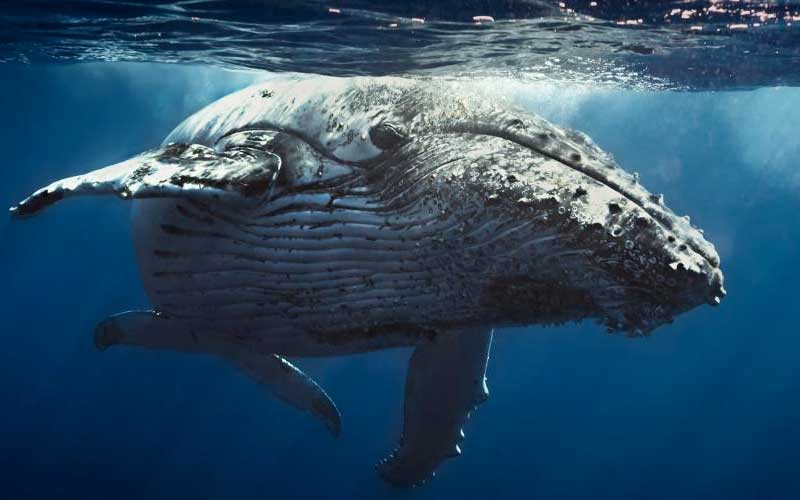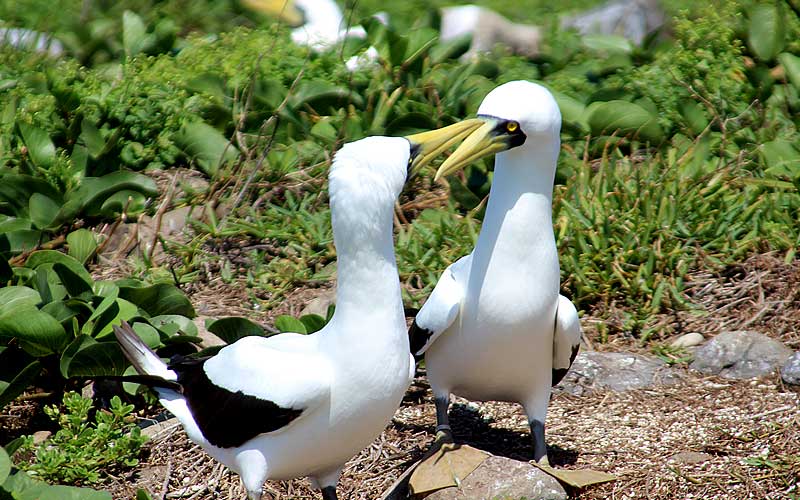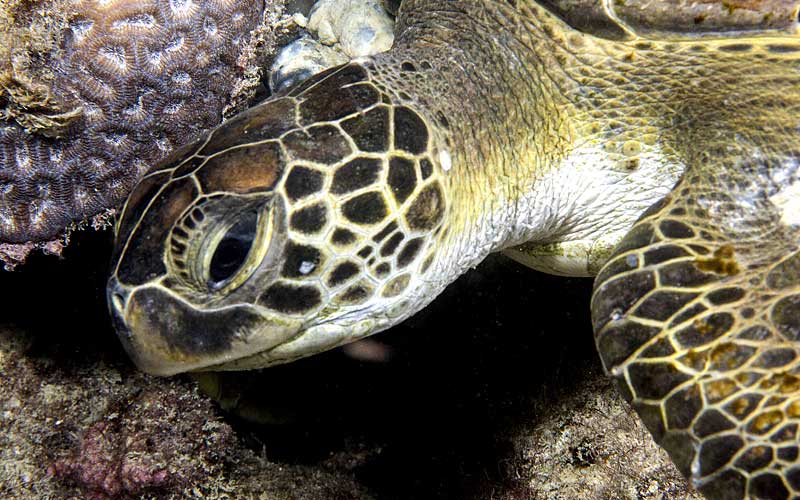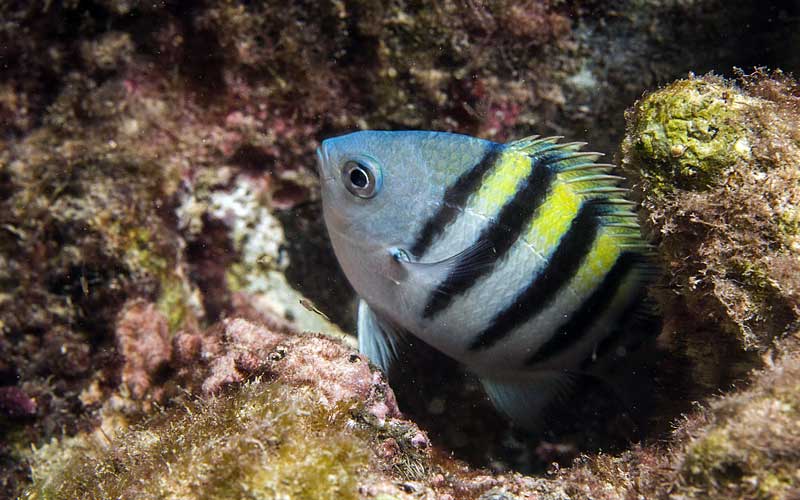Attractions
Abrolhos has an excellent area for scuba diving and free diving. The average temperature in winter is 24° C and in summer it is 28° C. The clear waters of the Park make it one of the main diving spots in Brazil as its coral formations harbor a great diversity of marine fauna besides wrecks of the last century. In the islands, the main attraction are the birds that build nests in the rock formations.
From July to October, the warm and calm waters of Abrolhos receive humpback whales, who migrate from Antarctica.
Take the opportunity to check the options of tours and schedule the one that suits you the most.
Diving Points
Portinho Sul
- Location: Santa Bárbara Island.
- Depth: 8 meters.
- Substrate: coral reef in strip.
- Marine life: coral reef formed by genre Mussismilia, with the three the M. hartti ; M. hispida and the endemic of southern Bahia, the brain coral M. brasiliensis. Several carnivorous reef fish such as grouper and barracudas. Herbivores like queen parrotfish, surgeon, blue parrotfish and parrotfish Scarus zelindae , who lives in harem and his female changes sex to complete the shoal in the absence of the male.
- Location: Santa Bárbara Island.
- Depth: 12 meters.
- Substrate: rocky shore.
- Marine life: gorgonians elephant ear (octocoral), giant anemone, shoals of snappers, sergeant major, trunkfish, lobsters and rays. In addition there are building remains of lighthouse and houses construction.
- Location: Siriba Island.
- Depth: 10 meters.
- Substrate: coral reef in strip.
- Marine life: Coral reef with species of crustaceans, mollusks and lots of fish species like groupers, shoals of snappers, blue parrotfish, cowfish, angelfish, butterfly fish, moray eels, filefishes and others.
da Siriba
- Location: Siriba Island.
- Depth: 12 meters.
- Substrate: rocky coast with formation of small caves and passages up to 10 meters long.
- Marine life: several species of algae, shoals of grunts and goatfish and others.
da Sueste
- Location: near the Sueste Island.
- Depth: 15 meters.
- Substrate: coral reef with plate formation with annual average growth of 01 mm. Several banks of calcareous algae in rhodolith with cover rate around 60% of the bottom.
- Marine life: lobsters, large groupers moving very close to the visitors divers together also shoals of snapper, blue tangs, grunts, parrotfish, angelfish and sometimes a nurse shark. There are tube sponges, anemones and fire corals too.
- Location: Santa Bárbara Island.
- Depth: 8 meters.
- Substrate: coral reef in strip.
- Marine life: Coral reef of genre Mussismilia, and predominantly covered by colonies of coral endemic in southern Bahia the M. brasiliensis , several carnivorous reef fish such as snappers, grouper, barracudas. Herbivores like real parrot, surgeon, blue parrotfish. Ornamental like Gramma brasiliensis, butterflyfish, ble tang, damselfish and several cleaners.
- Location: Santa Bárbara Island.
- Depth: 6 meters.
- Substrate: rocky shore.
- Sea life: gorgonian elephant ear coral, giant anemone, shoal of porkfish, blue tang, grunts, spotted eagle ray and parrotfish, octopus and squid.
Jean Pierre
- Location: Parcel dos Abrolhos.
- Depth: 24 meters.
- Substrate: reef shaped like a chapeirão.
- Marine life: endemic structure in southern Bahia with average annual growth of 1 mm, with several passages and tunnels that connect onewith other surrounding. M. hartti , M. híspida, Milepora alcicomes and endemic in southern Bahia the brain coral M. brasiliensis, several carnivorous and herbivorous reef fish.
- Location: Parcel dos Abrolhos.
- Depth: 25 meters.
- Substrate: reef shaped like a chapeirão.
- Marine life: endemic structure in southern Bahia with average annual growth of 1 mm, with several passages that are connected. M. hartti, M. híspida, Milepora alcicornes and endemic in southern Bahia the brain coral M. brasiliensis, carnivorous reef fish, herbivores and cleaners found next to anemones.
Faca Cega
- Location: Parcel dos Abrolhos.
- Depth: 29 meters.
- Substrate: reef shaped like a chapeirão.
- Marine life: endemic structure in southern Bahia with average annual growth of 1 mm, with several passages that are connected. M. hartti, M. híspida, Milepora alcicornes and endemic in southern Bahia the brain coral M. brasiliensis, carnivorous reef fish, herbivores and cleaners found next to anemones.
- Location: Parcel dos Abrolhos.
- Depth: 30 meters.
- Substrate: reef shaped like a chapeirão
- Marine life: endemic structure in southern Bahia, where they found several passages and tunnels that connect to a large hall, with height and width that give conditions for about 15 divers are together at the same time contemplating this cathedral is being built by marine creatures to at least 20,000 years. There, in addition to several species of corals and other organisms with calcareous skeleton, they are sometimes found large fish such as sharks, rays and groupers.
Shipwrecks
Catharina
- Date Wreckage: 08/16/1914
- Location: Abrolhos – Bahia – Brazil
- Latitude: 18 ° .02 ‘S
- Longitude: 38 °. 43 ‘W
- Depth: 14 m (minimum) 25 m (maximum)
- Current conditions: half-integer
- Reason of sinking: Sunk by the cruiser Glasgow
- Nationality: German
- Owner: Hamburg Sudamerica Line
- Length: 106.7 meters
- Displacement: 4,257 tons
- Type of vessel: Freighter
- Hull material: Iron
- Propulsion: Steam
- Charge: Kerosene drums, cement and agricultural implements
- Date Wreckage: 10/28/1955
- Location: Abrolhos – Bahia – Brazil
- Latitude: 17 ° 57.32 ‘S
- Longitude: 038 ° 38.42 ‘W
- Depth: 20 m (maximum)
- Current conditions: full
- Reason of sinking: shock
- Italian nationality
- Owner: Hamburg Sudamerica Line
- Length: 102.2 meters – mouth: 13.3 meters
- Displacement: 5,000 tons
- Type of vessel: Freighter
- Hull Material: Steel
- Propulsion: Propeller
- Cargo: cement and beer
- Date Wreckage: 06/20/1885
- Location: Abrolhos – Bahia – Brazil
- Latitude: 17 ° 53,102 ‘S
- Longitude: 038 ° 39,616 ‘W
- Depth: 9 m (minimum) 27 m (maximum)
- Current conditions: half-integer
- Reason of sinking: shock
- Owner: Royal Main Steam Packet CO.
- Length: 110 meters – mouth: 12 meters
- Displacement: 2,504 tons
- Type of vessel: bellboy
- Hull material: Iron
- Propulsion: mixed (sail / steam)
- Load: 1,800 tons of coffee
Reefs
Among its main attractions are the chapeirões, columns of coral of up to 20 meters of height that rise abruptly of the sea bottom and open in arcs near the surface like immense submarine mushrooms.
The waters, always warm and of turquoise blue color, hide true sanctuaries where inhabits an infinity of marine beings. The main species forming the chapeirões is the coral-brain, which is only found in the Bahian coast.
Abrolhos is home to another 15 reef-forming coral species. On the reefs closest to the coast, the chapeirons are so close together that they form true platforms.

An adult humpback is up to 16 meters long and weighs up to 40 tons. One means of recognizing it is by the white pectoral fins and very large in relation to the size of the body – they can reach up to a third of the total length of the animal.
The gestation of a humpback lasts for about a year and the puppy, which is already born about 3 meters long, weighing up to three tons, suckles about 200 liters of milk a day during the first year of life.
The whaling in Brazil has been banned since 1987 after more than a decade of campaigning and activism by whale advocacy organizations against the interests of businessmen and politicians involved in the whaling industry.
According to the IUCN and the Plan of Action for Brazilian Aquatic Mammals (IBAMA – 97/2001), humpback whales are classified as vulnerable and included in the official list of species of Brazilian fauna threatened with extinction (IBAMA 1522 Dec. 10, 1989). Of an original population estimated at 250,000 in all oceans, there are approximately 35,000 individuals.

The white Atobás (Sula Dactylatra) are the predominant birds in the Abrolhos archipelago. To catch the fish they feed on, the atobás can dive up to 8 meters into the sea. They have developed this ability due to a gland they possess beneath the tail feathers. By passing the beak into a fat-producing gland, and rubbing it through the body it waterproofs its feathers. After completing the waterproofing work, he dives, picks up his food, and leaves the dry water, ready to start flying again.
Atobás also usually have their beak open for air intake. According to researchers, this movement happens so that it heats up after the dives.
The coloration of some parts of the islands alternates between the black of the rocks and the white of the guano (excrement) of the beneditos (Anous stolidus). From March to November, Guarita Island becomes the main breeding place for this bird.


